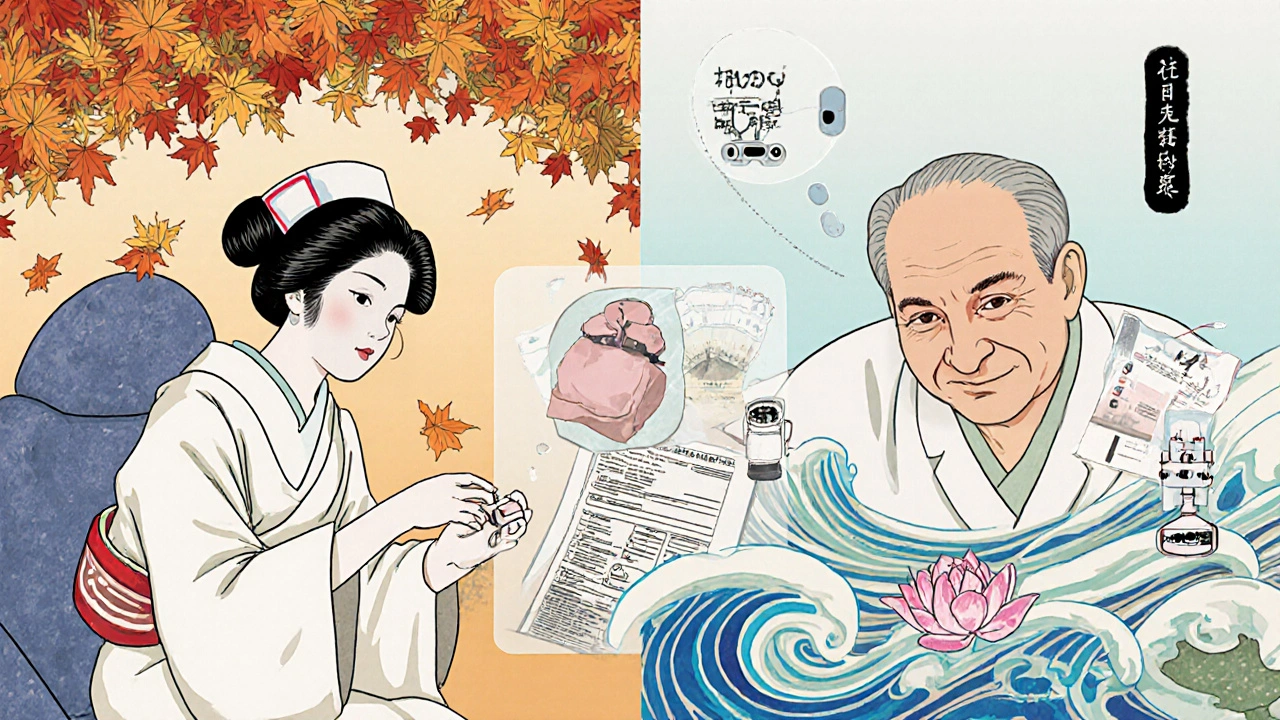
When a hospital decides to switch from a brand-name blood pressure pill to a generic version, it’s not just a cost-cutting move. It’s the result of a detailed, evidence-based process led by a team of pharmacists, doctors, and economists. This process is called the formulary system, and it’s how hospitals make sure patients get the right drugs at the right price-without sacrificing safety or effectiveness.
What Is a Hospital Formulary?
A hospital formulary is a living list of medications approved for use inside that facility. It’s not a static catalog. It’s updated regularly-often quarterly in big hospitals-based on new data, drug shortages, or changes in clinical guidelines. Think of it like a curated menu: only the drugs that pass strict clinical and financial reviews make the cut. Most U.S. hospitals use a closed formulary, meaning only approved drugs are stocked and prescribed routinely. If a doctor wants to use something not on the list, they usually need to jump through hoops-like getting prior authorization or justifying why the non-formulary drug is necessary. About 87% of U.S. hospitals operate this way, according to a 2022 study in PMC. That’s far higher than in nursing homes or outpatient clinics. The goal? As the American Society of Health-System Pharmacists (ASHP) puts it: “The safest, most effective medications that will produce the desired goals of therapy at the most reasonable cost.” That’s the triple bottom line: safety, effectiveness, and affordability.How Generic Drugs Get Approved
Not every generic drug automatically gets added. Just because the FDA says a generic is bioequivalent doesn’t mean a hospital will accept it. The FDA’s Orange Book confirms that a generic drug delivers the same amount of active ingredient into the bloodstream as the brand-name version-within an 80% to 125% range. But hospitals go further. The Pharmacy and Therapeutics (P&T) committee, made up of pharmacists, physicians, and sometimes nurses or economists, reviews each candidate. They look at:- Clinical evidence: At least 15-20 peer-reviewed studies on efficacy and safety in real patient populations.
- Safety profile: Adverse event reports from the FDA’s database, especially for drugs with narrow therapeutic windows like warfarin or lithium.
- Cost-effectiveness: Not just the sticker price, but how the drug affects hospital stays, readmissions, and complications.
- Formulation differences: A generic pill might look different, have different fillers, or come in a different shape. These can impact how patients take it. One study found that patients were more likely to skip doses if the generic looked unfamiliar.
Tiers and Costs: Why Generics Win
Hospital formularies are usually divided into three to five tiers. Generics almost always land in Tier 1-the lowest cost tier for patients. That means patients pay the least out of pocket, and the hospital saves money too. In 2023, IQVIA reported that generic drugs made up 90% of all prescriptions filled in U.S. hospitals but only accounted for 26% of total drug spending. That’s the power of the formulary. By steering prescribers toward generics, hospitals cut costs dramatically without hurting outcomes. Studies show hospitals following ASHP guidelines reduce medication costs by 18-22% without increasing adverse events. But it’s not just about price. The most advanced systems now look at the total cost of care. Dr. Steven J. Simoens from KU Leuven says, “A cheaper drug that leads to a longer hospital stay or a readmission isn’t really cheaper.” That’s why some hospitals use predictive analytics to model how a drug choice might affect patient outcomes weeks or months later.
Who Decides? The P&T Committee
The P&T committee is the engine of the formulary system. These aren’t just doctors and pharmacists chatting over coffee. They’re highly trained professionals who meet regularly-often monthly-to review new drug requests. Each request requires a full dossier: clinical trial data, pharmacokinetic studies, manufacturer pricing, and comparisons to existing formulary drugs. The average review takes 45 to 60 days. For urgent cases-like a new generic for a life-saving drug during a shortage-it can be fast-tracked to 14-21 days. Committees typically have 12-15 members. Everyone must have relevant expertise: pharmacists with Board Certification in Pharmacotherapy (BCPP), physicians with specialty training, and often a healthcare economist. Conflict of interest training is mandatory. Since 2020, every ASHP-accredited program requires annual training to prevent pharmaceutical reps from influencing decisions. Still, pressure exists. Dr. Jerry Avorn from Harvard found that pharmaceutical reps still visit hospitals and leave promotional materials-even when they’re not supposed to. “It’s subtle,” he wrote in JAMA Internal Medicine. “A free lunch, a branded pen, a ‘clinical update’ that’s really a sales pitch.” Hospitals counter this with strict disclosure rules and independent reviews from groups like the Institute for Clinical and Economic Review (ICER), which 65% of large systems now use.Challenges and Conflicts
Even the best systems have friction. Physicians sometimes complain. A 2021 AMA survey found 32% of doctors felt formulary restrictions had negatively affected patient care. One doctor in Texas told Sermo: “I had a patient with atrial fibrillation. The formulary only approved one anticoagulant. It caused nausea. The next best option wasn’t on the list. We lost three weeks getting approval.” Pharmacists face their own battles. A 2022 American Pharmacists Association survey found 57% of pharmacists had conflicts with doctors over generic substitutions. “I can legally swap the brand for the generic,” one pharmacist said. “But the doctor says, ‘I prescribed this for a reason.’ We end up in a tug-of-war.” Nurses report workflow disruptions. When a formulary changes, they have to relearn drug names, dosages, and appearances. A 2023 thread on AllNurses.com showed 73% of nurses had seen medication errors during transitions. “One day it’s ‘Lisinopril 10mg,’ the next it’s ‘Lisinopril HCTZ 10/12.5’-same pill, different name, different color. I almost gave the wrong one,” wrote one nurse. Drug shortages are another constant headache. In 2022, ASHP tracked 268 generic drugs in short supply. Hospitals respond by creating “therapeutic alternatives committees” that pre-identify backup drugs. Mayo Clinic’s system has a 98% success rate in keeping patients on therapy during shortages.
It’s amazing how much thought goes into something most people assume is just about cost. I’ve seen nurses scramble when a generic switches colors or shape-this system actually protects patients more than we realize.
The FDA's 80-125% bioequivalence range is a JOKE. How can you possibly call that 'equivalent'? You're gambling with lives. And don't even get me started on the pharmaceutical lobby controlling P&T committees through 'free lunches' and branded pens. This entire system is a rigged casino.
Real-world evidence and health equity being added to guidelines is a huge step forward. We’ve ignored disparities for too long. If a drug works poorly for Black patients or low-income elders, it shouldn’t be on the formulary-regardless of price.
Pharmacogenomics integration is the logical next frontier. CYP2C19 poor metabolizers require alternative antiplatelets-why are we still relying on population-level averages when we can personalize therapy at the genetic level? The data is robust, and the cost-benefit ratio is compelling.
Oh wow, so now we're using predictive analytics to guess if someone will get readmitted because of a generic? That’s just… terrifying. What’s next? AI deciding if your grandma deserves the expensive brand-name drug because she’s ‘high value’? This isn’t medicine anymore-it’s a spreadsheet with a stethoscope. And don’t even get me started on the nurses who almost gave the wrong pill because the color changed. This system isn’t saving lives-it’s creating new disasters.
Formularies save lives. Not because they’re cheap. Because they’re smart.
They say ‘evidence-based’ but they’re ignoring the fact that generics vary in bioavailability by up to 20%-and that’s not even counting fillers that trigger allergies in 12% of patients. The FDA doesn’t require dissolution testing across all populations. This is a corporate shell game disguised as science.
Wait so you’re telling me my aunt’s blood pressure med changed color and now she’s scared to take it? That’s wild. I told her to just keep taking it but she’s convinced it’s poison now. Like… why do they even change the damn pill? It’s the same chemical!
They say it’s about safety but they’re just letting Big Pharma dictate what we get. Did you know the same generic pill is made in the same factory as the brand? The only difference is the label. They’re all the same. But they make us jump through hoops because they want to control the narrative. The P&T committee? Just a puppet show with white coats.
Let me be clear: this entire formulary system is a controlled demolition of patient autonomy. They use ‘cost-effectiveness’ as a euphemism for rationing. And the ‘predictive analytics’? That’s just algorithmic bias dressed in lab coats. Who coded these models? Who decided what ‘optimal outcomes’ look like? And why are they ignoring the 32% of doctors who say it harms care? This isn’t medicine-it’s corporate eugenics with a formulary.
In India we don’t have formularies like this. Doctors just prescribe what they know works. Sometimes it’s brand, sometimes it’s generic. No committees. No approvals. Just trust between patient and provider. Maybe we’re missing something… or maybe you’re overcomplicating it
Why do we even bother with generics? Everyone knows the brand name works better. The system is broken because they’re punishing patients for being poor. If you can’t afford the brand, you get the cheap one that might not work. And now they’re using genetics to decide who gets what? That’s not science-it’s discrimination wrapped in a white coat.
I’ve worked in rural clinics where the only option was a generic lisinopril with a different coating. Patients would stop taking it because they said it made their mouth feel weird. We had to switch back to brand because adherence was dropping. The system assumes everyone has the same experience-but they don’t. Maybe we need more flexibility, not more rules.
I’ve been on both sides of this-first as a pharmacist pushing for generics to cut costs, then as a family member whose parent had a bad reaction to a new generic. The system tries to be fair, but it’s rigid. We need better communication-not just between doctors and pharmacists, but with patients too. If someone’s confused about why their pill changed color or shape, they need to be told, not just handed a new bottle. And maybe we need a simple patient-facing guide: ‘This is the same medicine, just made by someone else.’ That’s all it takes to rebuild trust.